Management Frames
Management is a large component of the 802.11 specification. Several different types of management frames are used to provide services that are simple on a wired network. Establishing the identity of a network station is easy on a wired network because network connections require dragging wires from a central location to the new workstation. In many cases, patch panels in the wiring closet are used to speed up installation, but the essential point remains: new network connections can be authenticated by a personal visit when the new connection is brought up.
Wireless networks must create management features to provide similar functionality. 802.11 breaks the procedure up into three components. Mobile stations in search of connectivity must first locate a compatible wireless network to use for access. With wired networks, this step typically involves finding the appropriate data jack on the wall. Next, the network must authenticate mobile stations to establish that the authenticated identity is allowed to connect to the network. The wired-network equivalent is provided by the network itself. If signals cannot leave the wire, obtaining physical access is at least something of an authentication process. Finally, mobile stations must associate with an access point to gain access to the wired backbone, a step equivalent to plugging the cable into a wired network.
The Structure of Management Frames
802.11 management frames share the structure shown in Figure 4-20. The MAC header is the same in all management frames; it does not depend on the frame subtype. Management frames use information elements, little chunks of data with a numerical label, to communicate information to other systems.
Figure 4-20. Generic management frame

Address fields
As with all other frames, the first address field is used for the frame's destination address. Some management frames are used to maintain properties within a single BSS. To limit the effect of broadcast and multicast management frames, stations are required to inspect the BSSID after receiving a mangement frame, though not all implementations perform BSSID filtering. Only broadcast and multicast frames from the BSSID that a station is currently associated with are passed to MAC management layers. The one exception to this rule is Beacon frames, which are used to announce the existence of an 802.11 network.
BSSIDs are assigned in the familiar manner. Access points use the MAC address of the wireless network interface as the BSSID. Mobile stations adopt the BSSID of the access point they are currently associated with. Stations in an IBSS use the randomly generated BSSID from the BSS creation. One exception to the rule: frames sent by the mobile station seeking a specific network may use the BSSID of the network they are seeking, or they may use the broadcast BSSID to find all networks in the vicinity.
Duration calculations
Management frames use the Duration field in the same manner that other frames do:
- Any frames transmitted in the contention-free period set the duration to 32,768.
- Frames transmitted during the contention-based access periods using only the DCF use the Duration field to block access to the medium to allow any atomic frame exchanges to complete.
- If the frame is a broadcast or multicast (the destination address is a group address), the duration is 0. Broadcast and multicast frames are not acknowledged, so the NAV is not needed to block access to the medium.
- If a nonfinal fragment is part of a multiframe exchange, the duration is set to the number of microseconds taken up by three SIFS intervals plus the next fragment and its acknowledgment.
- Final fragments use a duration that is the time required for one acknowledgment plus one SIFS.
Frame body
Management frames are quite flexible. Most of the data contained in the frame body uses fixed-length fields called fixed fields and variable-length fields called information elements. Information elements are blobs of data of varying size. Each data blob is tagged with a type number and a size, and it is understood that an information element of a certain type has its data field interpreted in a certain way. New information elements can be defined by newer revisions to the 802.11 specification; implementations that predate the revisions can ignore newer elements. Old implementations depend on backward-compatible hardware and frequently can't join networks based on the newer standards. Fortunately, new options usually can be easily turned off for compatibility.
This section presents the fixed fields and information elements as building blocks and shows how the building blocks are assembled into management frames. 802.11 mandates the order in which information elements appear, but not all elements are mandatory. This book shows all the frame building blocks in the specified order, and the discussion of each subtype notes which elements are rare and which are mutually exclusive.
Fixed-Length Management Frame Components
10 fixed-length fields may appear in management frames. Fixed-length fields are often referred to simply as fields to distinguish them from the variable-length information elements. Fields do not have a header to distinguish them from other parts of the frame body. Because they have a fixed length and appear in a known order, fields can be delimited without using a field header.
Authentication Algorithm Number
Two bytes are used for the Authentication Algorithm Number field, which are shown in Figure 4-21. This field identifies the type of authentication used in the initial 802.11-level authentication process before association occurs. 802.1X authentication occurs after association, and is not assigned an algorithm number. (The authentication process is discussed more thoroughly in Chapter 8.) The values permitted for this field are shown in Table 4-3. Only two values are currently defined. Other values are reserved for future standardization work.
Figure 4-21. Authentication Algorithm Number field

|
Value |
Meaning |
|---|---|
|
0 |
Open System authentication (typically used with 802.1X authentication) |
|
1 |
Shared Key authentication (deprecated by 802.11i) |
|
2-65,535 |
Reserved |
Authentication Transaction Sequence Number
Authentication is a multistep process that consists of a challenge from the access point and a response from the mobile station attempting to associate. The Authentication Transaction Sequence Number, shown in Figure 4-22, is a two-byte field used to track progress through the authentication exchange. It takes values from 1 to 65,535; it is never set to 0. Use of this field is discussed in Chapter 8.
Figure 4-22. Authentication Transaction Sequence Number field

Beacon interval
Beacon transmissions announce the existence of an 802.11 network at regular intervals. Beacon frames carry information about the BSS parameters and the frames buffered by access points, so mobile stations must listen to Beacons. The Beacon Interval, shown in Figure 4-23, is a 16-bit field set to the number of time units between Beacon transmissions. One time unit, which is often abbreviated TU, is 1,024 microseconds (ms), which is about 1 millisecond.[*] Time units may also be called kilo-microseconds in various documentation (Kms or kms). It is common for the Beacon interval to be set to 100 time units, which corresponds to an interval between Beacon transmissions of approximately 100 milliseconds or 0.1 seconds.
[*] Kilo-microseconds are an odd blend of the powers-of-2 used in computing for the kilo, and the more common 1/1,000 for micro. Presumably, the International Bureau of Weights and Measures would protest the mangling of the traditional form of the prefixes.
Figure 4-23. Beacon Interval field

Capability Information
The 16-bit Capability Information field (Figure 4-24) is used in Beacon transmissions to advertise the network's capabilities. Capability Information is also used in Probe Request and Probe Response frames. In this field, each bit is used as a flag to advertise a particular function of the network. Stations use the capability advertisement to determine whether they can support all the features in the BSS. Stations that do not implement all the features in the capability advertisement are not allowed to join.
Figure 4-24. Capability Information field

ESS/IBSS
These two bits are mutually exclusive. Access points set the ESS field to 1 and the IBSS field to 0 to indicate that the access point is part of an infrastructure network. Stations in an IBSS set the ESS field to 0 and the IBSS field to 1.
Privacy
Setting the Privacy bit to 1 requires the use of WEP for confidentiality. In infrastructure networks, the transmitter is an access point. In IBSSs, Beacon transmission must be handled by a station in the IBSS.
Short Preamble
This field was added to 802.11b to support the high-rate DSSS PHY. Setting it to 1 indicates that the network is using the short preamble as described in Chapter 12. Zero means the option is not in use and is forbidden in the BSS. 802.11g requires use of the short preamble, so this field is always set to 1 in a network built on the 802.11g standard.
PBCC
This field was added to 802.11b to support the high-rate DSSS PHY. When it is set to 1, it indicates that the network is using the packet binary convolution coding modulation scheme described in Chapter 12, or the higher-speed 802.11g PBCC modulation described in Chapter 14. Zero means that the option is not in use and is forbidden in the BSS.
Channel Agility
This field was added to 802.11b to support the high rate DSSS PHY. When it is set to one, it indicates that the network is using the Channel Agility option described in Chapter 12. Zero means the option is not in use and is forbidden in the BSS.
Short Slot Time (802.11g)
This bit is set to one to indicate the use of the shorter slot time supported by 802.11g, which is discussed in Chapter 14.
DSSS-OFDM (802.11g)
This bit is set to one to indicate that the optional DSSS-OFDM frame construction in 802.11g is in use.
Contention-free polling bits
Stations and access points use these two bits as a label. The meanings of the labels are shown in Table 4-4.
|
CF-Pollable |
CF-Poll Request |
Interpretation |
|---|---|---|
|
Station usage |
||
|
0 |
0 |
Station does not support polling |
|
0 |
1 |
Station supports polling but does not request to be put on the polling list |
|
1 |
0 |
Station supports polling and requests a position on the polling list |
|
1 |
1 |
Station supports polling and requests that it never be polled (results in station treated as if it does not support contention-free operation) |
|
Access point usage |
||
|
0 |
0 |
Access point does not implement the point coordination function |
|
0 |
1 |
Access point uses PCF for delivery but does not support polling |
|
1 |
0 |
Access point uses PCF for delivery and polling |
|
1 |
1 |
Reserved; unused |
Current AP Address
Mobile stations use the Current AP Address field, shown in Figure 4-25, to indicate the MAC address of the access point with which they are associated. This field is used to ease associations and reassociations. Stations transmit the address of the access point that handled the last association with the network. When an association is established with a different access point, this field can be used to transfer the association and retrieve any buffered frames.
Figure 4-25. Current AP Address field
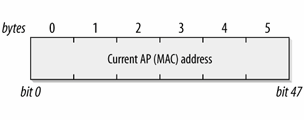
Listen interval
To save battery power, stations may shut off the antenna units in 802.11 network interfaces. While stations are sleeping, access points must buffer frames for them. Dozing stations periodically wake up to listen to traffic announcements to determine whether the access point has any buffered frames. When stations associate with an access point, part of the saved data is the Listen Interval, which is the number of Beacon intervals that stations wait between listening for Beacon frames. The Listen Interval, shown in Figure 4-26, allows mobile stations to indicate how long the access point must retain buffered frames. Higher listen intervals require more access point memory for frame buffering. Access points may use this feature to estimate the resources that will be required and may refuse resource-intensive associations. The Listen Interval is described in Chapter 8.
Figure 4-26. Listen Interval field

Association ID
The Association ID, shown in Figure 4-27, is a 16-bit field. When stations associate with an access point, they are assigned an Association ID to assist with control and management functions. Even though 14 bits are available for use in creating Association IDs, they range only from 1-2,007. To maintain compatibility with the Duration/ID field in the MAC header, the two most significant bits are set to 1.
Timestamp
The Timestamp field, shown in Figure 4-28, allows synchronization between the stations in a BSS. The master timekeeper for a BSS periodically transmits the number of microseconds it has been active. When the counter reaches its maximum value, it wraps around. (Counter wraps are unlikely given the length of time it takes to wrap a
Figure 4-27. Association ID field

64-bit counter. At over 580,000 years, I would bet on a required patch or two before the counter wrap.)
Figure 4-28. Timestamp field

Reason Code
Stations may send Disassociation or Deauthentication frames in response to traffic when the sender has not properly joined the network. Part of the frame is a 16-bit Reason Code field, shown in Figure 4-29, to indicate what the sender has done incorrectly. Table 4-5 shows why certain reason codes are generated. Fully understanding the use of reason codes requires an understanding of the different classes of frames and states of the 802.11 station, which is discussed in the section "Frame Transmission and Association and Authentication States."
Figure 4-29. Reason Code field

|
Code |
Explanation |
|---|---|
|
0 |
Reserved; unused |
|
1 |
Unspecified |
|
2 |
Prior authentication is not valid |
|
3 |
Station has left the basic service area or extended service area and is deauthenticated |
|
4 |
Inactivity timer expired and station was disassociated |
|
5 |
Disassociated due to insufficient resources at the access point |
|
6 |
Incorrect frame type or subtype received from unauthenticated station |
|
7 |
Incorrect frame type or subtype received from unassociated station |
|
8 |
Station has left the basic service area or extended service area and is disassociated |
|
9 |
Association or reassociation requested before authentication is complete |
|
10 (802.11h) |
Disassociated because of unacceptable values in Power Capability element |
|
11 (802.11h) |
Disassociated because of unacceptable values in Supported Channels element |
|
12 |
Reserved |
|
13 (802.11i) |
Invalid information element (added with 802.11i, and likely one of the 802.11i information elements) |
|
14 (802.11i) |
Message integrity check failure |
|
15 (802.11i) |
4-way keying handshake timeout |
|
16 (802.11i) |
Group key handshake timeout |
|
17 (802.11i) |
4-way handshake information element has different security parameters from initial parameter set |
|
18 (802.11i) |
Invalid group cipher |
|
19 (802.11i) |
Invalid pairwise cipher |
|
20 (802.11i) |
Invalid Authentication and Key Management Protocol |
|
21 (802.11i) |
Unsupported Robust Security Network Information Element (RSN IE) version |
|
22 (802.11i) |
Invalid capabilities in RSN information element |
|
23 (802.11i) |
802.1X authentication failure |
|
24 (802.11i) |
Proposed cipher suite rejected due to configured policy |
|
25-65,535 |
Reserved; unused |
Status Code
Status codes indicate the success or failure of an operation. The Status Code field, shown in Figure 4-30, is 0 when an operation succeeds and nonzero on failure. Table 4-6 shows the status codes that have been standardized.
Figure 4-30. Status Code field

|
Code |
Explanation |
|---|---|
|
0 |
Operation completed successfully |
|
1 |
Unspecified failure |
|
2-9 |
Reserved; unused |
|
10 |
Requested capability set is too broad and cannot be supported |
|
11 |
Reassociation denied; prior association cannot be identified and transferred |
|
12 |
Association denied for a reason not specified in the 802.11 standard |
|
13 |
Requested authentication algorithm not supported |
|
14 |
Unexpected authentication sequence number |
|
15 |
Authentication rejected; the response to the challenge failed |
|
16 |
Authentication rejected; the next frame in the sequence did not arrive in the expected window |
|
17 |
Association denied; the access point is resource-constrained |
|
18 |
Association denied; the mobile station does not support all of the data rates required by the BSS |
|
19 (802.11b) |
Association denied; the mobile station does not support the Short Preamble option |
|
20 (802.11b) |
Association denied; the mobile station does not support the PBCC modulation option |
|
21 (802.11b) |
Association denied; the mobile station does not support the Channel Agility option |
|
22 (802.11h) |
Association denied; Spectrum Management is required |
|
23 (802.11h) |
Association denied; Power Capability value is not acceptable |
|
24 (802.11h) |
Association denied; Supported Channels is not acceptable |
|
25 (802.11g) |
Association denied; the mobile station does not support the Short Slot Time |
|
26 (802.11g) |
Association denied; the mobile station does not support DSSS-OFDM |
|
27-39 |
Reserved |
|
40 (802.11i) |
Information element not valid |
|
41 (802.11i) |
Group (broadcast/multicast) cipher not valid |
|
42 (802.11i) |
Pairwise (unicast) cipher not valid |
|
43 (802.11i) |
Authentication and Key Management Protocol (AKMP) not valid |
|
44 (802.11i) |
Robust Security Network information element (RSN IE) version is not supported |
|
45 (802.11i) |
RSN IE capabilites are not supported |
|
46 (802.11i) |
Cipher suite rejected due to policy |
|
47-65,535 |
Reserved for future standardization work |
Management Frame Information Elements
Information elements are variable-length components of management frames. A generic information element has an ID number, a length, and a variable-length component, as shown in Figure 4-31. Standardized values for the element ID number are shown in Table 4-7.
Figure 4-31. Generic management frame information element

|
Element ID |
Name |
|---|---|
|
0 |
Service Set Identity (SSID) |
|
1 |
Supported Rates |
|
2 |
FH Parameter Set |
|
3 |
DS Parameter Set |
|
4 |
CF Parameter Set |
|
5 |
Traffic Indication Map (TIM) |
|
6 |
IBSS Parameter Set |
|
7 (802.11d) |
Country |
|
8 (802.11d) |
Hopping Pattern Parameters |
|
9 (802.11d) |
Hopping Pattern Table |
|
10 (802.11d) |
Request |
|
11-15 |
Reserved; unused |
|
16 |
Challenge text |
|
17-31 |
Reserveda (formerly for challenge text extension, before 802.11 shared key authentication was discontinued) |
|
32 (802.11h) |
Power Constraint |
|
33 (802.11h) |
Power Capability |
|
34 (802.11h) |
Transmit Power Control (TPC) Request |
|
35 (802.11h) |
TPC Report |
|
36 (802.11h) |
Supported Channels |
|
37 (802.11h) |
Channel Switch Announcement |
|
38 (802.11h) |
Measurement Request |
|
39 (802.11h) |
Measurement Report |
|
40 (802.11h) |
Quiet |
|
41 (802.11h) |
IBSS DFS |
|
42 (802.11g) |
ERP information |
|
43-49 |
Reserved |
|
48 (802.11i) |
Robust Security Network |
|
50 (802.11g) |
Extended Supported Rates |
|
32-255 |
Reserved; unused |
|
221b |
Wi-Fi Protected Access |
|
a 802.11 shared key authentication is no longer recommended, so it is unlikely that these fields will ever be used. |
|
|
a This is used by WPA, and is not an official part of 802.11. However, it is widely implemented, so I include it in the table. |
|
Service Set Identity (SSID)
Network managers are only human, and they usually prefer to work with letters, numbers, and names rather than 48-bit identifiers. 802.11 networks, in the broadest sense, are either extended service sets or independent BSSs. The SSID, shown in Figure 4-32, allows network managers to assign an identifier to the service set. Stations attempting to join a network may scan an area for available networks and join the network with a specified SSID. The SSID is the same for all the basic service areas composing an extended service area.
Figure 4-32. Service Set Identity information element

Some documentation refers to the SSID as the network name because network administrators frequently assign a character string to it. However, the SSID is just a string of bytes that labels the BSSID as belonging to a larger agglomeration. Some products require that the string be a garden variety ASCII string, though the standard has no requirement on the content of the string.
In all cases, the length of the SSID ranges between 0 and 32 bytes. The zero-byte case is a special case called the broadcast SSID; it is used only in Probe Request frames when a station attempts to discover all the 802.11 networks in its area.
Supported Rates
Several data rates have been standardized for wireless LANs. The Supported Rates information element allows an 802.11 network to specify the data rates it supports. When mobile stations attempt to join the network, they check the data rates used in the network. Some rates are mandatory and must be supported by the mobile station, while others are optional.
The Supported Rates information element is shown in Figure 4-33. It consists of a string of bytes. Each byte uses the seven low-order bits for the data rate; the most significant bit indicates whether the data rate is mandatory. Mandatory rates are encoded with the most significant bit set to 1 and optional rates have a 0. Up to eight rates may be encoded in the information element. As the number of data rates has proliferated, the Extended Supported Rates element was standardized to handle more than eight data rates.
In the initial revision of the 802.11 specification, the seven bits encoded the data rate as a multiple of 500 kbps. New technology, especially ETSI's HIPERLAN efforts, required a change to the interpretation. When 7 bits are used to have a multiple of
Figure 4-33. Supported Rates information element

500 kbps, the maximum data rate that can be encoded is 63.5 Mbps. Research and development on wireless LAN technology has made this rate achievable in the near future. As a result, the IEEE changed the interpretation from a multiple of 500 kbps to a simple label in 802.11b. Previously standardized rates were given labels corresponding to the multiple of 500 kbps, but future standards may use any value. Current standardized values are shown in Table 4-8.
|
Binary value |
Corresponding rate (Mbps) |
|---|---|
|
2 |
1 |
|
4 |
2 |
|
11 (802.11b) |
5.5 |
|
12 (802.11g) |
6 |
|
18 (802.11g) |
9 |
|
22 (802.11b) |
11 |
|
24 (802.11g) |
12 |
|
36 (802.11g) |
18 |
|
44 (802.11g) |
22 (optional 802.11g PBCC) |
|
48 (802.11g) |
24 |
|
66 (802.11g) |
33 (optional 802.11g PBCC) |
|
72 (802.11g) |
36 |
|
96 (802.11g) |
48 |
|
108 (802.11g) |
54 |
As an example, Figure 4-33 shows the encoding of two data rates. 2-Mbps service is mandatory and 11-Mbps service is supported. This is encoded as a mandatory 2-Mbps rate and an optional 11-Mbps rate.
FH Parameter Set
The FH Parameter Set information element, shown in Figure 4-34, contains all parameters necessary to join a frequency-hopping 802.11 network.
Figure 4-34. FH Parameter Set information element

The FH Parameter Set has four fields that uniquely specify an 802.11 network based on frequency hopping. Chapter 12 describes these identifiers in depth.
Dwell Time
802.11 FH networks hop from channel to channel. The amount of time spent on each channel in the hopping sequence is called the dwell time. It is expressed in time units (TUs).
Hop Set
Several hopping patterns are defined by the 802.11 frequency-hopping PHY. This field, a single byte, identifies the set of hop patterns in use.
Hop Pattern
Stations select one of the hopping patterns from the set. This field, also a single byte, identifies the hopping pattern in use.
Hop Index
Each pattern consists of a long sequence of channel hops. This field, a single byte, identifies the current point in the hop sequence.
DS Parameter Set
Direct-sequence 802.11 networks have only one parameter: the channel number used by the network. High-rate direct sequence networks use the same channels and thus can use the same parameter set. The channel number is encoded as a single byte, as shown in Figure 4-35.
Figure 4-35. DS Parameter Set information element

Traffic Indication Map (TIM)
Access points buffer frames for mobile stations sleeping in low-power mode. Periodically, the access point attempts to deliver buffered frames to sleeping stations. A practical reason for this arrangement is that much more power is required to power up a transmitter than to simply turn on a receiver. The designers of 802.11 envisioned battery-powered mobile stations; the decision to have buffered frames delivered to stations periodically was a way to extend battery life for low-power devices.
Part of this operation is to send the Traffic Indication Map (TIM) information element (Figure 4-36) to the network to indicate which stations have buffered traffic waiting to be picked up.
Figure 4-36. Traffic Indication Map information element

The meat of the traffic indication map is the virtual bitmap, a logical structure composed of 2,008 bits. Each bit is tied to the Association ID. When traffic is buffered for that Association ID, the bit is 1. If no traffic is buffered, the bit tied to the Association ID is 0.
DTIM Count
This one-byte field is the number of Beacons that will be transmitted before the next DTIM frame. DTIM frames indicate that buffered broadcast and multicast frames will be delivered shortly. Not all Beacon frames are DTIM frames.
DTIM Period
This one-byte field indicates the number of Beacon intervals between DTIM frames. Zero is reserved and is not used. The DTIM count cycles through from the period down to 0.
Bitmap Control and Partial Virtual Bitmap
The Bitmap Control field is divided into two subfields. Bit 0 is used for the traffic indication status of Association ID 0, which is reserved for multicast traffic. The remaining seven bits of the Bitmap Control field are used for the Bitmap Offset field.
To save transmission capacity, the Bitmap Offset field can be used to transmit a portion of the virtual bitmap. The Bitmap Offset is related to the start of the virtual bitmap. By using the Bitmap Offset and the Length, 802.11 stations can infer which part of the virtual bitmap is included.
CF Parameter Set
The CF Parameter Set information element is transmitted in Beacons by access points that support contention-free operation. Contention-free service is discussed in Chapter 9 because of its optional nature.
IBSS Parameter Set
IBSSs currently have only one parameter, the announcement traffic indication map (ATIM) window, shown in Figure 4-37. This field is used only in IBSS Beacon frames. It indicates the number of time units (TUs) between ATIM frames in an IBSS.
Figure 4-37. IBSS Parameter Set information element
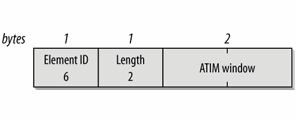
Country
The initial 802.11 specifications were designed around the existing regulatory constraints in place in the major industrialized countries. Rather than continue to revise the specification each time a new country was added, a new specification was added that provides a way for networks to describe regulatory constraints to new stations. The main pillar of this is the Country information element, shown in Figure 4-38.
Figure 4-38. Country information element

After the initial type/length information element header, there is a country identifier, followed by a series of three-byte descriptors for regulatory constraints. Each constraint descriptor specifies a unique band, and they may not overlap, since a given frequency has only one maximum allowed power.
Country String (3 bytes)
A three-character ASCII string of where the station is operating. The first two letters are the ISO country code (e.g., "US" for the United States). Many countries have different indoor and outdoor regulations, and the third character distinguishes between the two. When a single set of omnibus regulations covers all environments, the third character is a space. To designate indoor or outdoor regulations only, the third character may be set to "I" or "O", respectively.
First Channel Number (1 byte)
The first channel number is the lowest channel subject to the power constraint. Channel number assignment for each PHY is discussed in the appropriate chapter.
Number of Channels (1 byte)
The size of the band subject to the power constraint is indicated by the number of channels. The size of a channel is PHY-dependent.
Maximum Transmit Power (1 byte)
The maximum transmit power, expressed in dBm.
Pad (1 byte; optional)
The size of the information element must be an even number of bytes. If the length of the information element is an odd number of bytes, a single byte of zeroes is appended as a pad.
Hopping Pattern Parameters and Hopping Pattern Table
The initial 802.11 frequency hopping specification, described in Chapter 11, was built around the regulatory constraints in effect during its design. These two elements can be used to build a hopping pattern that complies with regulatory constraints in additional countries, which allows further adoption of the frequency-hopping PHY without requiring additional revision to the specification.
Request
In Probe Request frames, the Request information element is used to ask the network for certain information elements. The Request information element has the type/length header, and is followed by a list of integers with the numbers of the information elements being requested (Figure 4-39).
Figure 4-39. Request information element

Challenge Text
The shared-key authentication system defined by 802.11 requires that the mobile station successfully decrypt an encrypted challenge. The challenge is sent using the Challenge Text information element, which is shown in Figure 4-40.
Power Constraint
The Power Constraint information element is used to allow a network to describe the maximum transmit power to stations. In addition to a regulatory maximum, there may be another maximum in effect. The only field, a one-byte integer, is the number
Figure 4-40. Challenge Text information element

of decibels by which any local constraint reduces the regulatory maximum. If, for example, the regulatory maximum power were 10 dBm, but this information element contained the value 2, then the station would set its maximum transmit power to 8 dBm (Figure 4-41).
Figure 4-41. Power Constraint information element
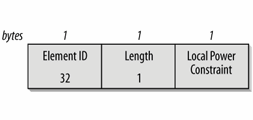
Power Capability
802.11 stations are battery powered, and often have radios that are not as capable as access points, in part because there is not usually the need for mobile client devices to transmit at high power. The Power Capability information element allows a station to report its minimum and maximum transmit power, in integer units of dBm (Figure 4-42).
Figure 4-42. Power Capability information element
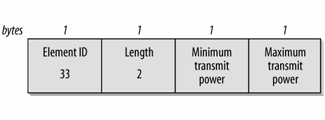
TPC Request
The Transmit Power Control (TPC) Request information element is used to request radio link management information. It has no associated data, so the length field is always zero (Figure 4-43).
Figure 4-43. Transmit Power Request information element
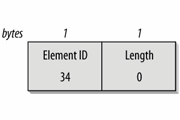
TPC Report
For stations to know how to tune transmission power, it helps to know the attenuation on the link. TPC Report information elements are included in several types of management frames, and include two one-byte fields (Figure 4-44). The first, the transmit power, is the transmit power of the frame containing the information element, in units of dBm. The second, the link margin, represents the number of decibels of safety that the station requires. Both are used by the station to adapt its transmission power, as described in Chapter 8.
Figure 4-44. Transmit Power Report information element
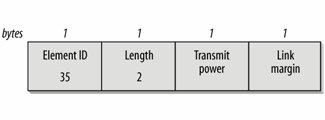
Supported Channels
The Supported Channels information element is similar to the Country information element, in that it describes sub-bands that are supported. After the header, there is a series of sub-band descriptors. Each sub-band descriptor consists of a first channel number, which is the lowest channel in a supported sub-band, followed by the number of channels in the sub-band (Figure 4-45). For example, a device that only supported channels 40 through 52 would set the first channel number to 40, and the number of channels to 12.
Figure 4-45. Supported Channels information element
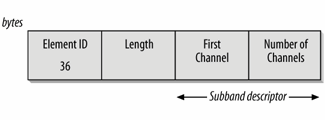
Channel Switch Announcement
802.11h added the ability of networks to dynamically switch channels. To warn stations in the network about the impending channel change, management frames may include the Channel Switch Announcement element shown in Figure 4-46.
Figure 4-46. Channel Switch Announcement information element

Channel Switch Mode
When the operating channel is changed, it disrupts communication. If this field is set to 1, associated stations should stop transmitting frames until the channel switch has occurred. If it is set to zero, there is no restriction on frame transmission.
New Channel Number
The new channel number after the switch. At present, there is no need for this field to exceed a value of 255.
Channel Switch Count
Channel switching can be scheduled. This field is the number of Beacon frame transmission intervals that it will take to change the channel. Channel switch occurs just before the Beacon transmission is to begin. A non-zero value indicates the number of Beacon intervals to wait; a zero indicates that the channel switch may occur without any further warning.
Measurement Request and Measurement Report
Regular channel measurements are important to monitoring the channel and power settings. Two information elements are defined to allow stations to request measurements and receive reports. Reports are a key component of 802.11h, and will be discussed in detail in the "Spectrum Management" section of Chapter 8.
Quiet
One of the reasons for the development of dynamic frequency selection was the need to avoid certain military radar technologies. To find the presence of radar or other interference, an AP can use the Quiet element, shown in Figure 4-47, to temporarily shut down the channel to improve the quality of measurements.
Figure 4-47. Quiet information element

Following the header, there are four fields:
Quiet Count
Quiet periods are scheduled. The count is the number of Beacon transmission intervals until the quiet period begins. It works in a similar fashion to the Channel Switch Count field.
Quiet Period
Quiet periods may also be periodically scheduled. If this field is zero, it indicates there are no scheduled quiet periods. A non-zero value indicates the number of beacon intervals between quiet periods.
Quiet Duration
Quiet periods do not need to last for an entire Beacon interval. This field specifies the number of time units the quiet period lasts.
Quiet Offset
Quiet periods do not necessarily have to begin with a Beacon interval. The Offset field is the number of time units after a Beacon interval that the next quiet period will begin. Naturally, it must be less than one Beacon interval.
IBSS DFS
In an infrastructure network, the access point is responsible for dynamic frequency selection. Independent networks must have a designated owner of the dynamic frequency selection (DFS) algorithm. Management frames from the designated station in an IBSS may transmit the IBSS DFS information element, shown in Figure 4-48.
Figure 4-48. IBSS Dynamic Frequency Selection (DFS) information element

After the header, it has the MAC address of the station responsible for maintaining DFS information, as well as a measurement interval. The bulk of the frame is a series of channel maps, which report what is detected on each channel. The channel map consists of a channel number, followed by a map byte, which has the following fields:
BSS (1 bit)
This bit will be set if frames from another network are detected during a measurement period.
OFDM Preamble (1 bit)
This bit is set if the 802.11a short training sequence is detected, but without being followed by the rest of the frame. HIPERLAN/2 networks use the same preamble, but obviously not the same frame construction.
Unidentified Signal (1 bit)
This bit is set when the received power is high, but the signal cannot be classified as either another 802.11 network (and hence, set the BSS bit), another OFDM network (and hence, set the OFDM Preamble bit), or a radar signal (and hence, set the Radar bit). The standard does not specify what power level is high enough to trigger this bit being set.
Radar (1 bit)
If a radar signal is detected during a measurement period, this bit will be set. Radar systems which must be detected are defined by regulators, not the 802.11 task group.
Unmeasured (1 bit)
If the channel was not measured, this bit will be set. Naturally, when there was no measurement taken, nothing can be detected in the band and the previous four bits will be set to zero.
ERP Information
802.11g defined the extended rate PHY (ERP). To provide backwards compatibility, the ERP information element, shown in Figure 4-49, was defined. In its first iteration, it is three bit flags in a single byte.
Non-ERP present
This bit will be set when an older, non-802.11g station associates to a network. It may also be set when overlapping networks that are not capable of using 802.11g are detected.
Use Protection
When stations incapable of operating at 802.11g data rates are present, the protection bit is set to 1. This enables backwards compatibility with older stations, as described in Chapter 14.
Barker Preamble Mode
This bit will be set if the stations which have associated to the network are not capable of the short preamble mode described in Chapter 12.
Figure 4-49. ERP information element

Robust Security Network
With the significant security enhancements in 802.11i, it was necessary to develop a way to communicate security information between stations. The main tool for this is the Robust Security Network (RSN) information element, shown in Figure 4-50. There are several variable components, and in some cases, the RSN information element might run into the limits of the information element size of 255 bytes past the header.
Version
The version field must be present. 802.11i defined version 1. Zero is reserved, and versions of two or greater are not yet defined.
Figure 4-50. Robust Security Network (RSN) information element

Group cipher suite
Following the version number is the group cipher suite descriptor. Access points must select a single group cipher compatible with all associated stations to protect broadcast and multicast frames. Only one group cipher is allowed.
A cipher suite selector is four bytes long. It starts with an OUI for the vendor, and a number to identify the cipher. Table 4-9 shows the standardized cipher suites. (Values not shown in the table are reserved.) The OUI used by 802.11i is 00-0F-AC, which is used by the 802.11 working group.
|
OUI |
Suite Type |
Definition |
|---|---|---|
|
00-0F-AC (802.11) |
0 |
Use the group cipher suite (only valid for pairwise ciphers) |
|
00-0F-AC |
1 |
WEP-40 |
|
00-0F-AC |
2 |
TKIP |
|
00-0F-AC |
3 |
Reserved |
|
00-0F-AC |
4 |
CCMPa |
|
00-0F-AC |
5 |
WEP-104 |
|
Vendor OUI |
Any value |
Defined by vendor |
|
a This is the default value for an 802.11i network. |
||
Pairwise Cipher Suites (count + list)
Following the group cipher suite may be several pairwise cipher suites to protect unicast frames. There is a two-byte count, followed by a series of supported cipher descriptors. The suite selector may be set to zero to indicate support for only the group cipher suite. There is no limit, other than the size of the information element, on the number of supported pairwise ciphers.
Authentication and Key Management (AKM) suites (count + list)
Like the pairwise cipher suite selector, there may be multiple authentication types defined. Following a count, there is a series of four-byte suite identifiers. As with the cipher suites, the four-byte identifier consists of an OUI and a suite type number. Table 4-10 shows the standard authentication types.
|
OUI |
Suite type |
Authentication |
Key management |
|---|---|---|---|
|
00-0F-AC |
1 |
802.1X or PMK caching |
Key derivation from preshared master key, as described in Chapter 7 |
|
00-0F-AC |
2 |
Pre-shared key |
Key derivation from pre-shared key, as described in Chapter 7 |
|
Vendor OUI |
Any |
Vendor-specific |
Vendor-specific |
RSN Capabilties
This two-byte field consists of four flags used to describe what the transmitter is capable of, followed by reserved bits that must be set to zero.
Pre-authentication
An AP may set this bit to indicate it can perform pre-authentication with other APs on the network to move security sessions around. Otherwise, this bit is set to zero. Preauthentication is discussed in Chapter 8.
No Pairwise
This bit is set when a station can support a manual WEP key for broadcast data in conjunction with a stronger unicast key. Although supported by the standard, this configuration should not be used unless absolutely necessary.
Pairwise Replay Counter and Group Replay Counter
Separate replay counters may be maintained for each priority level defined in emerging quality of service extensions. These bits describe the number of replay counters supported by the station.
PMK list (count + list)
Faster hand-offs between access points are possible when the pairwise master key is cached by the AP. Stations may provide a list of master keys to an AP on association in an attempt to bypass the time-consuming authentication. PMK caching is discussed in more detail in Chapter 8.
Extended Supported Rates
The Extended Supported Rates information element acts identically to the Supported Rates element in Figure 4-33, but it allows an information element body of up to 255 bytes to be supported.
Wi-Fi Protected Access (WPA)
Wi-Fi Protected Access is a slight modification of a subset of 802.11i, designed to bring TKIP to the market more quickly. It is identical to the Robust Security Network information element in Figure 4-50, but with the following changes:
- The element ID is 221, not 48.
- A WPA-specific tag of 00:50:F2:01 is inserted before the version field.
- Microsoft's OUI (00:50:F2) is used instead of the 802.11 working group's OUI.
- Only one cipher suite and one authentication suite are supported in the information element. However, many WPA implementations do not follow this restriction.
- TKIP is the default cipher, rather than CCMP.
- Preauthentication is not supported in WPA, so the preauthentication capabilities bit is always zero.
Types of Management Frames
The fixed fields and information elements are used in the body of management frames to convey information. Several types of management frames exist and are used for various link-layer maintenance functions.
Beacon
Beacon frames announce the existence of a network and are an important part of many network maintenance tasks. They are transmitted at regular intervals to allow mobile stations to find and identify a network, as well as match parameters for joining the network. In an infrastructure network, the access point is responsible for transmitting Beacon frames. The area in which Beacon frames appear defines the basic service area. All communication in an infrastructure network is done through an access point, so stations on the network must be close enough to hear the Beacons.
Figure 4-51 shows most the fields that can be used in a Beacon frame in the order in which they appear. Not all of the elements are present in all Beacons. Optional fields are present only when there is a reason for them to be used. The FH and DS Parameter Sets are used only when the underlying physical layer is based on frequency hopping or direct-sequence techniques. Only one physical layer can be in use at any point, so the FH and DS Parameter Sets are mutually exclusive.
The CF Parameter Set is used only in frames generated by access points that support the PCF, which is optional. The TIM element is used only in Beacons generated by access points, because only access points perform frame buffering. If the Country-specific frequency hopping extensions were to be present, they would follow the Country information element. Frequency hopping networks are much less common now, though, so I omit the frequency hopping extensions for simplicity. Likewise, the IBSS DFS element occur between the Quiet and TPC Report elements, were it to appear.
Figure 4-51. Beacon frame
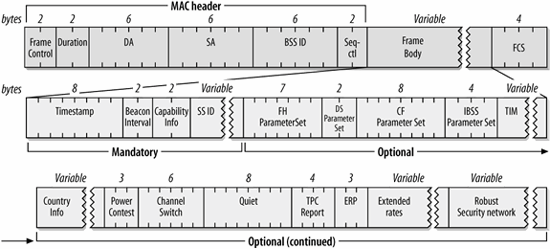
Probe Request
Mobile stations use Probe Request frames to scan an area for existing 802.11 networks. The format of the Probe Request frame is shown in Figure 4-52. All fields are mandatory.
Figure 4-52. Probe Request frame

A Probe Request frame contains two fields: the SSID and the rates supported by the mobile station. Stations that receive Probe Requests use the information to determine whether the mobile station can join the network. To make a happy union, the mobile station must support all the data rates required by the network and must want to join the network identified by the SSID. This may be set to the SSID of a specific network or set to join any compatible network. Drivers that allow cards to join any network use the broadcast SSID in Probe Requests.
Probe Response
If a Probe Request encounters a network with compatible parameters, the network sends a Probe Response frame. The station that sent the last Beacon is responsible for responding to incoming probes. In infrastructure networks, this station is the access point. In an IBSS, responsibility for Beacon transmission is distributed. After a station transmits a Beacon, it assumes responsibility for sending Probe Response frames for the next Beacon interval. The format of the Probe Response frame is shown in Figure 4-53. Some of the fields in the frame are mutually exclusive; the same rules apply to Probe Response frames as to Beacon frames.
Figure 4-53. Probe Response frame
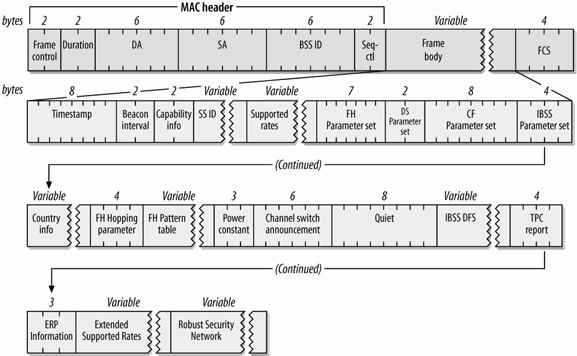
The Probe Response frame carries all the parameters in a Beacon frame, which enables mobile stations to match parameters and join the network. Probe Response frames can safely leave out the TIM element because stations sending probes are not yet associated and thus would not need to know which associations have buffered frames waiting at the access point.
IBSS announcement traffic indication map (ATIM)
IBSSs have no access points and therefore cannot rely on access points for buffering. When a station in an IBSS has buffered frames for a receiver in low-power mode, it sends an ATIM frame during the delivery period to notify the recipient it has buffered data. See Figure 4-54.
Figure 4-54. ATIM frame

Disassociation and Deauthentication
Disassociation frames are used to end an association relationship, and Deauthentication frames are used to end an authentication relationship. Both frames include a single fixed field, the Reason Code, as shown in Figure 4-55. Of course, the Frame Control fields differ because the subtype distinguishes between the different types of management frames. 802.11 revisions did not need to change the format, but many have added new reason codes.
Figure 4-55. Disassociation and Deauthentication frames

Association Request
Once mobile stations identify a compatible network and authenticate to it, they may attempt to join the network by sending an Association Request frame. The format of the Association Request frame is shown in Figure 4-56.
Figure 4-56. Association Request frame

The Capability Information field is used to indicate the type of network the mobile station wants to join. Before an access point accepts an association request, it verifies that the Capability Information, SSID, and (Extended) Supported Rates all match the parameters of the network. Access points also note the Listen Interval, which describes how often a mobile station listens to Beacon frames to monitor the TIM. Stations that support spectrum management will have the power and channel capability information elements, and stations supporting security will have the RSN information element.
Reassociation Request
Mobile stations moving between basic service areas within the same extended service area need to reassociate with the network before using the distribution system again. Stations may also need to reassociate if they leave the coverage area of an access point temporarily and rejoin it later. See Figure 4-57.
Figure 4-57. Reassociation Request frame

Association and Reassociation Requests differ only in that a Reassociation Request includes the address of the mobile station's current access point. Including this information allows the new access point to contact the old access point and transfer the association data. The transfer may include frames that were buffered at the old access point.
Association Response and Reassociation Response
When mobile stations attempt to associate with an access point, the access point replies with an Association Response or Reassociation Response frame, shown in Figure 4-58. The two differ only in the subtype field in the Frame Control field. All fields are mandatory. As part of the response, the access point assigns an Association ID. How an access point assigns the association ID is implementation-dependent.
Figure 4-58. (Re)Association Response frame

Authentication
At the beginning of 802.11 networking, stations authenticated using a shared key, and exchanged Authentication frames, which are shown in Figure 4-59. With 802.11i, shared key authentication was kept in the standard, but made incompatible with the new security mechanisms. If a station uses shared key authentication, it will not be allowed to use the strong security protocols described in Chapter 8.
Figure 4-59. Authentication frames

Different authentication algorithms may co-exist. The Authentication Algorithm Number field is used for algorithm selection. The authentication process may involve a number of steps (depending on the algorithm), so there is a sequence number for each frame in the authentication exchange. The Status Code and Challenge Text are used in different ways by different algorithms; details are discussed in Chapter 8.
Action frame
802.11h added support for Action frames, which trigger measurements. These frames will be described in detail in the "Spectrum Management" section of Chapter 8.
Introduction to Wireless Networking
- Introduction to Wireless Networking
- Why Wireless?
- What Makes Wireless Networks Different
- A Network by Any Other Name...
Overview of 802.11 Networks
- Overview of 802.11 Networks
- IEEE 802 Network Technology Family Tree
- 11 Nomenclature and Design
- 11 Network Operations
- Mobility Support
11 MAC Fundamentals
- 11 MAC Fundamentals
- Challenges for the MAC
- MAC Access Modes and Timing
- Contention-Based Access Using the DCF
- Fragmentation and Reassembly
- Frame Format
- Encapsulation of Higher-Layer Protocols Within 802.11
- Contention-Based Data Service
- Frame Processing and Bridging
11 Framing in Detail
- 11 Framing in Detail
- Data Frames
- Control Frames
- Management Frames
- Frame Transmission and Association and Authentication States
Wired Equivalent Privacy (WEP)
- Wired Equivalent Privacy (WEP)
- Cryptographic Background to WEP
- WEP Cryptographic Operations
- Problems with WEP
- Dynamic WEP
User Authentication with 802.1X
- User Authentication with 802.1X
- The Extensible Authentication Protocol
- EAP Methods
- 1X: Network Port Authentication
- 1X on Wireless LANs
11i: Robust Security Networks, TKIP, and CCMP
- 11i: Robust Security Networks, TKIP, and CCMP
- The Temporal Key Integrity Protocol (TKIP)
- Counter Mode with CBC-MAC (CCMP)
- Robust Security Network (RSN) Operations
Management Operations
- Management Operations
- Management Architecture
- Scanning
- Authentication
- Preauthentication
- Association
- Power Conservation
- Timer Synchronization
- Spectrum Management
Contention-Free Service with the PCF
- Contention-Free Service with the PCF
- Contention-Free Access Using the PCF
- Detailed PCF Framing
- Power Management and the PCF
Physical Layer Overview
- Physical Layer Overview
- Physical-Layer Architecture
- The Radio Link
- RF Propagation with 802.11
- RF Engineering for 802.11
The Frequency-Hopping (FH) PHY
- The Frequency-Hopping (FH) PHY
- Frequency-Hopping Transmission
- Gaussian Frequency Shift Keying (GFSK)
- FH PHY Convergence Procedure (PLCP)
- Frequency-Hopping PMD Sublayer
- Characteristics of the FH PHY
The Direct Sequence PHYs: DSSS and HR/DSSS (802.11b)
- The Direct Sequence PHYs: DSSS and HR/DSSS (802.11b)
- Direct Sequence Transmission
- Differential Phase Shift Keying (DPSK)
- The Original Direct Sequence PHY
- Complementary Code Keying
- High Rate Direct Sequence PHY
11a and 802.11j: 5-GHz OFDM PHY
- 11a and 802.11j: 5-GHz OFDM PHY
- Orthogonal Frequency Division Multiplexing (OFDM)
- OFDM as Applied by 802.11a
- OFDM PLCP
- OFDM PMD
- Characteristics of the OFDM PHY
11g: The Extended-Rate PHY (ERP)
- 11g: The Extended-Rate PHY (ERP)
- 11g Components
- ERP Physical Layer Convergence (PLCP)
- ERP Physical Medium Dependent (PMD) Layer
A Peek Ahead at 802.11n: MIMO-OFDM
11 Hardware
- 11 Hardware
- General Structure of an 802.11 Interface
- Implementation-Specific Behavior
- Reading the Specification Sheet
Using 802.11 on Windows
11 on the Macintosh
Using 802.11 on Linux
- Using 802.11 on Linux
- PCMCIA Support on Linux
- Linux Wireless Extensions and Tools
- Agere (Lucent) Orinoco
- Atheros-Based cards and MADwifi
- 1X on Linux with xsupplicant
Using 802.11 Access Points
- Using 802.11 Access Points
- General Functions of an Access Point
- Power over Ethernet (PoE)
- Selecting Access Points
- Cisco 1200 Access Point
- Apple AirPort
Logical Wireless Network Architecture
- Logical Wireless Network Architecture
- Evaluating a Logical Architecture
- Topology Examples
- Choosing Your Logical Architecture
Security Architecture
- Security Architecture
- Security Definition and Analysis
- Authentication and Access Control
- Ensuring Secrecy Through Encryption
- Selecting Security Protocols
- Rogue Access Points
Site Planning and Project Management
- Site Planning and Project Management
- Project Planning and Requirements
- Network Requirements
- Physical Layer Selection and Design
- Planning Access-Point Placement
- Using Antennas to Tailor Coverage
11 Network Analysis
11 Performance Tuning
Conclusions and Predictions
EAN: 2147483647
Pages: 179
